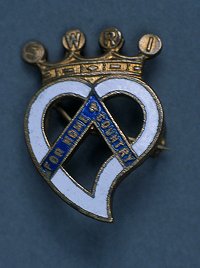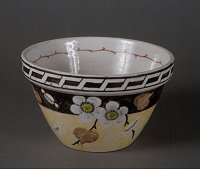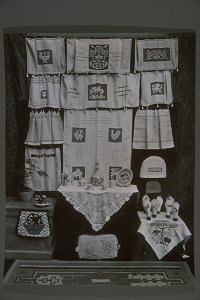Contents ![]() | Institutes of learning
| Institutes of learning ![]() | Sources
| Sources ![]()

SWRI: Growth and Consolidation
Page 2 of 2 | Previous
The movement grew. So popular were the institutes that in 1929 one opened at Herdmanflat Hospital in Haddington. It was the 29th in East Lothian where they were led from 1922 by a County Federation. This body oversaw the creation of nine choirs and organised sporting competitions and educational outings. It celebrated its fiftieth anniversary in 1972 with a buffet and musical evening.
The Luckenbooth Brooch
The Board of Agriculture for Scotland had taken an early interest in 'the Rurals'. It asked for a badge, the winning design coming from Glamis WRI based on an old Scottish love token. The design incorporated four jewels, each bearing a letter to read SWRI and the motto 'For Home and Country'. The white heart stands for purity and the gold crown of womanhood stands for courage and steadfastness.

Mak' Merry Ware
Blair was inspired to open a pottery studio in a shed on her farm. Institute members were encouraged to visit and paint pottery with their own designs. The enterprise had two goals. As well enabling women to express their artistic abilities, its ultimate goal was to provide those working in the studio with additional finances. It was, Blair believed, a 'co-operative rural enterprise'. She called herself 'the heid painter' and was ably assisted by a young helper called Betty Wight. Much of the finished work bore the distinctive mark, 'Mak' Merry' (a joke on the name Macmerry), that once again demonstrated Blair's mastery of short, witty phrases.
As well as selling the pieces at exhibitions and roadside markets, Catherine Blair organised a thriving export trade. The studio eventually moved to North Berwick, East Lothian, but continued to produce high quality pottery. At the Rural Industries Exhibition in the late 1930s the studio took both first and second places. Such was their desirability that at the 1933 Highland Show the Queen Mother ordered a crockery set.

The pottery was an extension of one of the two basic themes of the rural institutes: home and handcraft. Competitions were organised for both: for the home theme members still make preserves, baked goods, confectionery, quilts and lace and for the handcraft side members make pottery, baskets and furniture. These skills were very well demonstrated at the Lothians Federation of Women's Rural Institutes rally at the Dalkeith Corn Exchange in October 1923. The eighty classes of competition led to "assiduous preparations" by the competing Institutes.
Moving Forward
In 1967 the SWRI celebrated its golden jubilee at Gosford House in Longniddry, East Lothian, where an array of important figures celebrated fifty years of success. In addition, a conference was held at the Usher Hall in Edinburgh. Guests included the Lord and Lady Provost of Edinburgh and the Queen Mother who addressed the gathering. At the time of the golden jubilee the SWRI had 1,200 branches and around 56,000 members.
Page 2 of 2 | Previous
In this section:
Women's Co-operative Guilds | Scottish Women's Rural Institute | Literary and debating societies
Contents ![]() | Institutes of learning
| Institutes of learning ![]() | Sources
| Sources ![]()